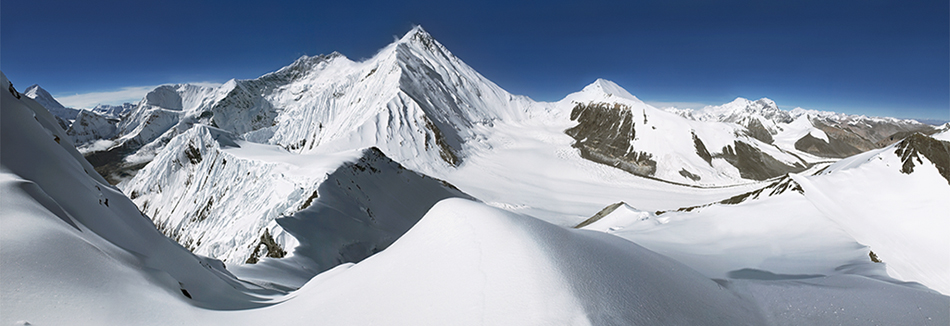Renaissanse frescoes
The essence of the Renaissance that spread from Italy throughout Europe consisted in the appeal to the cultural heritage of the Antiquity. Among all areas of culture, fine arts were in the foreground. It was a natural expression of the creative abilities of the people of that time. Art was a means of cognition of phenomena of the world. Although the artists created works on religious topics, they tried to express in them the people’s experience accumulated over the centuries. They filled the old Christian legends with new contents.

Humanistic ideas found their highest realization in the murals of the Sistine Chapel. They were commissioned by Pope Sixtus IV. The Chapel itself was built on his initiative in 1473. This is one of the Popes’ Worship Houses in their Vatican Palace in Rome. The inside of the building offers an oblong quadrangular hall (40, 23 x 13, 41 x 20, 7 m) with a vaulted ceiling. Between 1477 and 1480, Sixtus IV undertook its full reconstruction and invited the most famous artists to realize such a monumental plan. During the years 1481-1482, Pietro Perugino, Sandro Botticelli, Domenico Ghirlandaio, Cosimo Rosselli, Luca Signorelli and Pietro Cosimo executed the murals of the north and south walls of the chapel. The chapel that later was called the Sistine Chapel was opened on August 15, 1482. It was dedicated to the Assumption of the Mother of God.
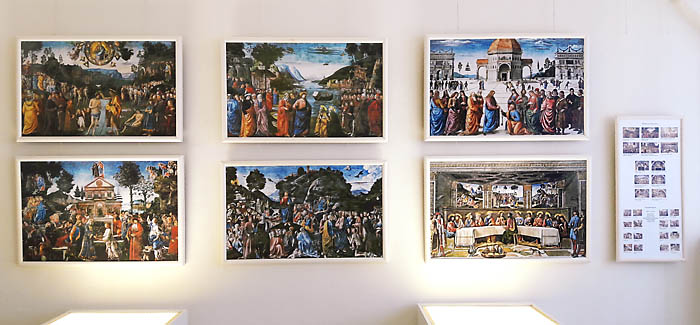
Pope Julius II wished to decorate the ceiling of the Chapel with frescoes. The work was done by Michelangelo within the period from 1508 to 1512. This painting amazing a viewer with its grandness, majesty, and harmony covers the whole surface of the vault (about 520 m2) and includes more than three hundred figures. In the centre there are nine narrative compositions with scenes from the biblical Book of Genesis, which show the creation of the world and man, the expulsion from the Paradise and the Deluge. On both sides from the main scenes there are five sibyls and seven prophets. They are full of inspiration predicting the coming of the God-man and symbolizing the joyful hopes of the human race expecting His appearance.
Pope Clemens VII suggested the idea of painting the scene of the Doomsday on the altar wall. Through the events of the past, he thought to show the whole range of possibilities for the art of drawing and painting. The next Pope to come after Clemens's death was Paul III. In his time Michelangelo got down to work on this fresco (1534-1541; 14 x 12 m). This painting was presented for viewing on Christmas Day. The work is considered to be the most perfect one.
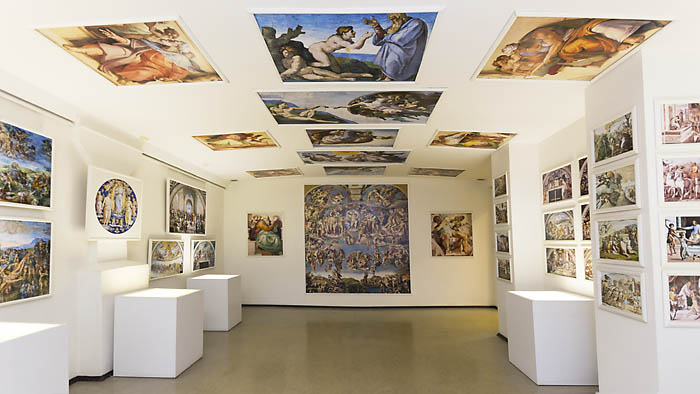
This fresco is perceived as an event occurring beyond the space of the chapel. Human bodies are like real architectonical forms and create an illusion that the figures are appearing from the outside occupying places around the formidable image of Christ the Judge.
The Mother of God, sitting beside Christ, renounces her traditional role as Mediatress. Turning away from what is happening, she with trepidation listens to the final sentence. Christ and the Mother of God are surrounded by innumerable figures of prophets, apostles, martyrs. St. Bartholomew is beneath Christ. He shows the skin stripped off from him, on which Michelangelo painted a self-portrait. At the feet of Christ there are seven angels described by the evangelist St. John. They blow the trumpets summoning to appear for judgment. Two of them have a book of lives in their hands. At the top wingless angels with the symbols of the Holy Passion of Christ soar in the air. The left-hand side of the mural shows the righteous ascending to the heavens, from which souls rush to their aid. The people's sinful desires in the guise of vile monsters are in the right-hand side. They cast the sinners into hell.
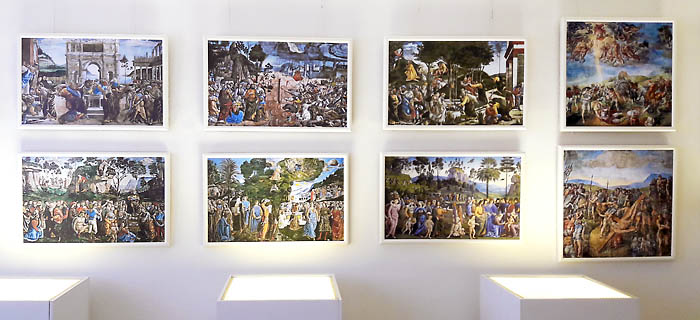
The last artistic works executed by Michelangelo were his frescoes Conversion of Saul (1542-1545; 625 x 661 cm at the base) and The Crucifixion of St. Peter (1546-1550) in the Cappella Paolina.
n 1507, Pope Julius II decided to move into a new residence in the Vatican Palace. He invited a group of artists to decorate the rooms. Julius II was insomuch impressed with Raphael's talent that he ordered to remove the frescoes already painted by other artists and those performed earlier, too. He commissioned the whole painting to Raphael solely. Out of respect for Perugino, his teacher, Raphael saved the painting of the vault Christ the Judge in the room known as the Stanza dell'Incendio.
The painting of the Stanza della Segnatura (1508-1511) that served as a papal library in the times of Julius II and as a study in the times of Leo X was the first work of Raphael in the Vatican. Due to this, Raphael gained the highest fame and recognition. In his frescoes La Disputa del Sacramento, Scuola di Atene (770 cm at the base), and Parnassus, Raphael reflected his vision of a perfect society and a perfect personality. Among the sages, poets, and theologians of the classic world, he placed the portraits of his contemporaries. He, as it were, brought the beauteous world of antiquity closer to that around him. Thus, he expressed an inspiring dream of the possibility of transforming the surrounding world into a new one where faith, science, and art would coexist in harmony and prosperity. This idea underlay the scenes of the frescoes and made them, along with the murals of the Sistine Chapel of Michelangelo and The Last Supper of Leonardo da Vinci, the masterpieces of the monumental painting of the High Renaissance.
In 1512-1514, Raphael painted Stanza d'Eliodoro (it is named after the fresco of the same name and connects Stanza della Segnatura with the Hall of Constantine). The plot of the painting developed the idea of the divine origin of the papal authority and the heavenly patronage of true faith and the church.
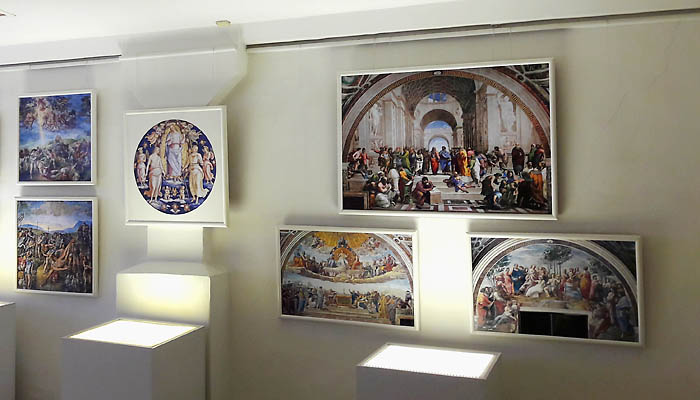
The hall next to the Stanza della Segnatura is the Stanza dell'Incendio (Fire Room). It opens the suite of ceremonial rooms and is named after the most significant fresco Incendio di Borgo (670 cm at the base). The mural depicts the assertion of spiritual power through political actions but with great praise for the ruling Pope Leo X. His portrait is depicted in all the frescoes and represented in the images of the two preceding papal saints of the same name. The frescoes of this hall were executed by Raphael's assistants in 1514-1517. Those were mainly Giulio Romano and Francesco Penny. They performed the painting in accordance with the master's drawings.
The loggia, attached to the eastern facade of the papal residence, was painted in 1517- 1519 by Raphael and the artists of his school of painting. Among the classical and secular motifs there are scenes from the Old and New Testaments known as the “Raphael’s Bible.”.
